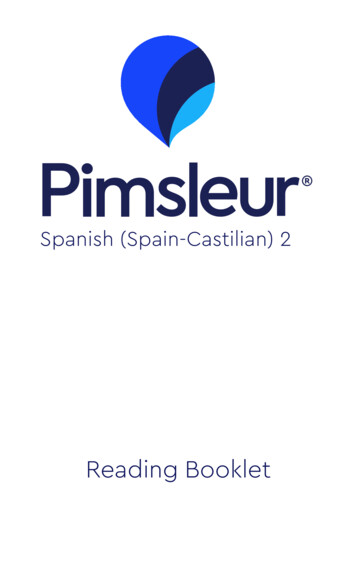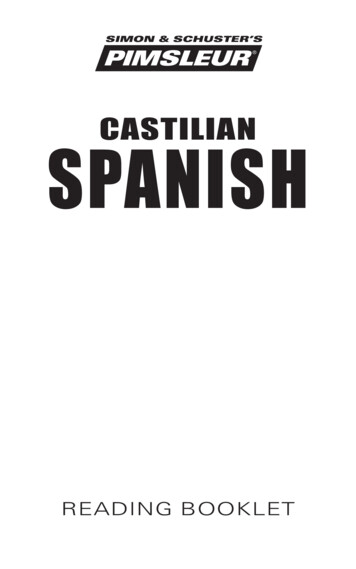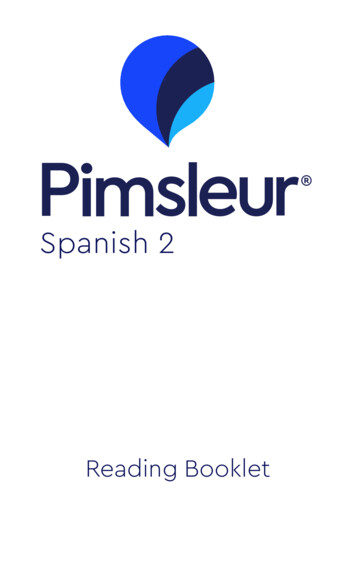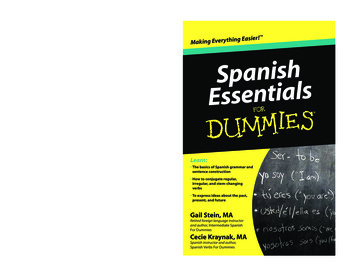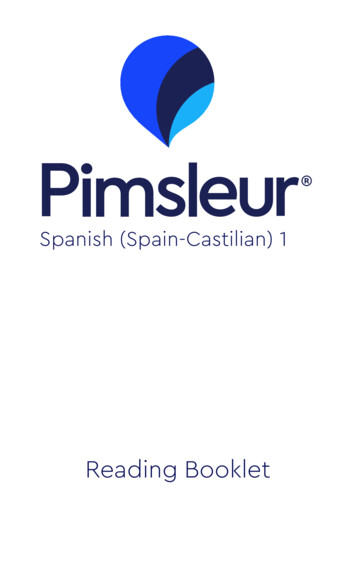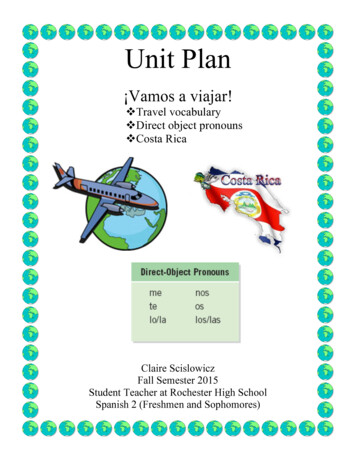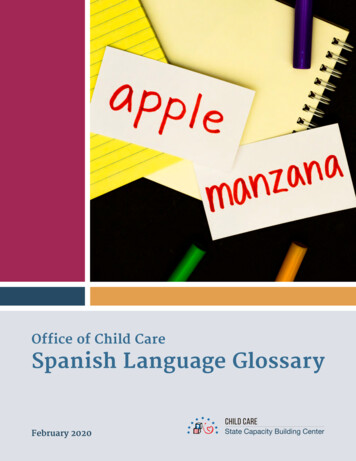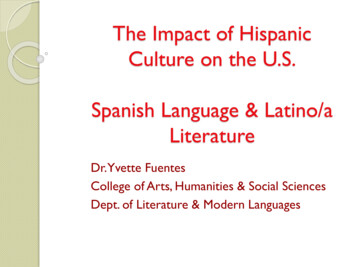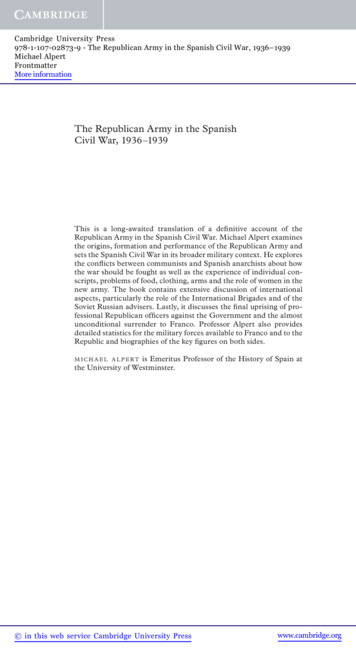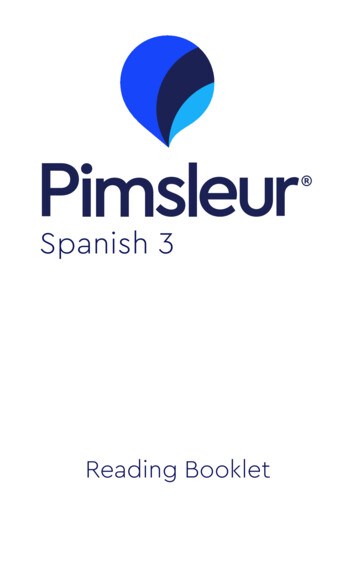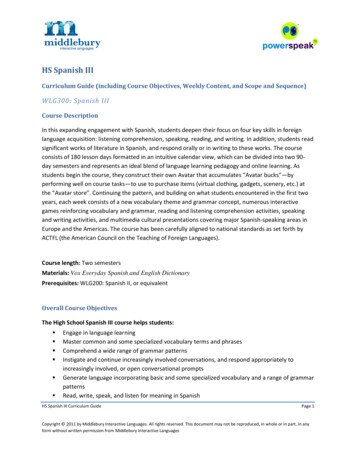
Transcription
HS Spanish IIICurriculum Guide (including Course Objectives, Weekly Content, and Scope and Sequence)WLG300: Spanish IIICourse DescriptionIn this expanding engagement with Spanish, students deepen their focus on four key skills in foreignlanguage acquisition: listening comprehension, speaking, reading, and writing. In addition, students readsignificant works of literature in Spanish, and respond orally or in writing to these works. The courseconsists of 180 lesson days formatted in an intuitive calendar view, which can be divided into two 90day semesters and represents an ideal blend of language learning pedagogy and online learning. Asstudents begin the course, they construct their own Avatar that accumulates “Avatar bucks”—byperforming well on course tasks—to use to purchase items (virtual clothing, gadgets, scenery, etc.) atthe “Avatar store”. Continuing the pattern, and building on what students encountered in the first twoyears, each week consists of a new vocabulary theme and grammar concept, numerous interactivegames reinforcing vocabulary and grammar, reading and listening comprehension activities, speakingand writing activities, and multimedia cultural presentations covering major Spanish-speaking areas inEurope and the Americas. The course has been carefully aligned to national standards as set forth byACTFL (the American Council on the Teaching of Foreign Languages).Course length: Two semestersMaterials: Vox Everyday Spanish and English DictionaryPrerequisites: WLG200: Spanish II, or equivalentOverall Course ObjectivesThe High School Spanish III course helps students: Engage in language learningMaster common and some specialized vocabulary terms and phrasesComprehend a wide range of grammar patternsInstigate and continue increasingly involved conversations, and respond appropriately toincreasingly involved, or open conversational promptsGenerate language incorporating basic and some specialized vocabulary and a range of grammarpatternsRead, write, speak, and listen for meaning in SpanishHS Spanish III Curriculum GuidePage 1Copyright 2011 by Middlebury Interactive Languages. All rights reserved. This document may not be reproduced, in whole or in part, in anyform without written permission from Middlebury Interactive Languages
Recognize and respond to significant works of literature in SpanishAnalyze and compare cultural practices, products, and perspectives of various Spanish-speakingcountriesRegularly assess progress in proficiency through quizzes, tests, and speaking/writing submissionsWeekly Content Vocabulary Themeo Each week presents a new set of vocabulary words through various self-correctingactivities. A printable vocabulary list, which includes pronunciation, is also provided.Grammar Concepto Each week introduces a new grammatical pattern. The concept is introduced throughsentence comparisons and presented in a printable explanation of the pattern.Reinforcement Activitieso A range of interactive games (incrementally increasing in challenge) helps studentsreinforce vocabulary and grammar concepts. These activities may be completedmultiple times so that students can better retain and apply the new information.Students accumulate “Avatar bucks” by performing well on these and other interactivechallenges.Presentation of Culture through Culture Videoso Each week students learn about various cultural aspects (e.g. practices, products, andperspectives) of a Spanish-speaking country. Culture videos present students with shortvideo explanations about cultural aspects of various Spanish-speaking countries from anative of that country.“Out of Seat” Activitieso Several times during the year, students are given opportunities to use the language“outside” the course. These are specific assignments directing students to interact in agenuine way with the Spanish language or Spanish-speaking cultures.Realiao Several times during the year, students work to decipher the key messages andsignificant details in Realias. In Realias, students confront authentic or semi-authentictexts in real-world, everyday situations. These encounters are neither trivial, nor farbeyond a student's comprehension level, but are texts to which students can respondand that move them to a deeper understanding of the target language and culture atthe same time. Sample texts include recipes, student class schedule, newspaperadvertisements, etc.Oral and Written Activitieso Each week, students complete oral and written activities. These activities give studentsa chance to become more familiar with the speaking and writing patterns of Spanish byapplying them in communicative situations.Literature Highlightso Approximately every other week, students read and respond (in speaking or writing) toa significant work of Spanish literature (typically from the AP Spanish Literature list)Listening and Reading Comprehension Activitieso Each week contains either a focused reading comprehension activity, or a listeningcomprehension activity. These activities help students to develop listening and readingcomprehension skills. They are based on the vocabulary, grammar, and/or cultureHS Spanish III Curriculum GuidePage 2
concepts presented that week, and follow up assessments challenge students to identifythe main ideas and significant details of these rich texts based on everydaycommunicative situations.Assessmentso Culture comprehension quizzes verify that students have captured facts andunderstandings from the cultural presentations.o Focused Listening or Reading quizzes verify that students comprehend the main ideas orsignificant details of target passages or conversations.o End-of-week quizzes assess students’ mastery of the vocabulary words and grammarconcept presented that week, and include an oral or written assessment.o Literature Highlights verify that students recognize main ideas and important details andcan respond to significant works in Spanish literature.o Midterm and Semester Exams assess students’ mastery of the semester’s contents up totheir current place on the calendar, and include oral and written assessments.Course Scope and SequenceSemester 1Vocabulary TopicGrammar PatternCultureWeek 1FamilyNouns, PronounsMexicoWeek 2Countries and NationalitiesAdjectivesMexicoWeek 3Numbers, Colors, and ShapesPossessive Pronouns andAdjectivesMexicoWeek 4Telling TimeDemonstrativesMexicoWeek 5Question words and NegativewordsObject PronounsSpainWeek 6DescriptionsAdverbsSpainWeek 7FoodPresent Tense Regular VerbsSpainWeek 8Body Parts and MedicalWordsPresent Tense Irregular VerbsSpainWeek 10The OfficePersonal ‘a’ColombiaWeek 11Computers and InternetReflexive VerbsColombiaVocabulary TopicWeek 12SchoolHS Spanish III Curriculum GuideGrammar PatternPor and ParaCultureColombiaPage 3
Week 13Calendar and HolidaysGustarColombiaWeek 14Around the HouseImpersonal “se”CubaWeek 15ChoresSer and EstarCubaWeek 16Sports and LeisureSaber/Conocer andPedir/PreguntarCubaWeek 17Hobbies and PastimesHaber and Hacer ExpressionsCuba(Week 9 and 18 are Midterm and Finals weeks)Semester 2Vocabulary TopicGrammar PatternCultureWeek 1ClothingComparativesPeruWeek 2ShoppingImperfect TensePeruWeek 3Outdoor ActivitiesPreterit TensePeruWeek 4Music and InstrumentsPreterit IrregularPeruWeek 5TransportationImperfect vs. PreteritCosta RicaWeek 6TravelFutureCosta RicaWeek 7Around the City, PositionWordsConditionalCosta RicaWeek 8Slang and ProverbsPerfectsCosta RicaWeek 10Common –AR verbsProgressivesBoliviaWeek 11Common –ER verbsPassive VoiceBoliviaWeek 12Common –IR verbsSubjunctive MoodBoliviaWeek 13Adverbs of frequency,conjunctions, prepositionsPresent SubjunctiveBoliviaVocabulary TopicGrammar PatternCultureWeek 14Telephone Conversations andDatingPresent Subjunctive IrregularArgentinaWeek 15ProfessionsImperfect SubjunctiveArgentinaHS Spanish III Curriculum GuidePage 4
Week 16Crime and PunishmentMore SubjunctiveArgentinaWeek 17Social IssuesImperative MoodArgentina(Week 9 and 18 are Midterm and Finals weeks)Works represented in the “Literature Highlights” include the following:Rubén Darío, Canción de otoño en primaveraLuis de Góngora y Argote, Mientras por competir con tu cabelloSor Juana Inés de la Cruz, En perseguirme, Mundo, ¿qué interesas?José Martí, Dos patriasLazarillo de Tormes, Lazarillo de Tormes, Capítulo 1Don Juan Manuel, Cuento XXXV: Lo que sucedió a un mozo que casó con una muchacha de muy malcarácterHoracio Quiroga, El hijoGarcilaso de la Vega, Soneto XXIIIGustavo Adolfo Bécquer, Rimas: LIII "Volverán las oscuras golondrinasJosé de Espronceda, Canción de pirataMiguel de Cervantes Saavedra, Don QuijoteFrancisco de Quevedo y Villegas, Miré los muros de la patria míaHS Spanish III Curriculum GuidePage 5
HS Spanish III Curriculum Guide Page 5 Week 16 Crime and Punishment More Subjunctive Argentina Week 17 Social Issues Imperative Mood Argentina (Week 9 and 18 are Midterm and Finals weeks) Works represented in the “Literature Highlights” include the following: Ru
